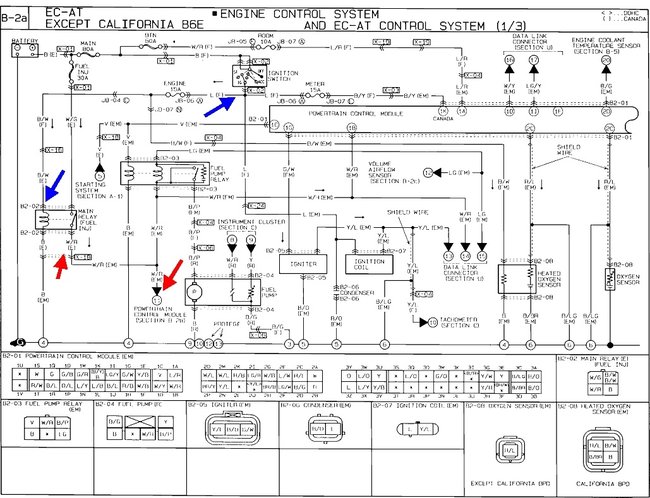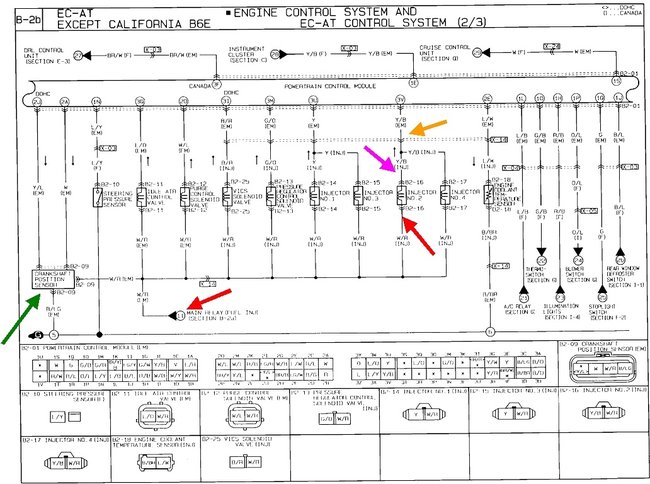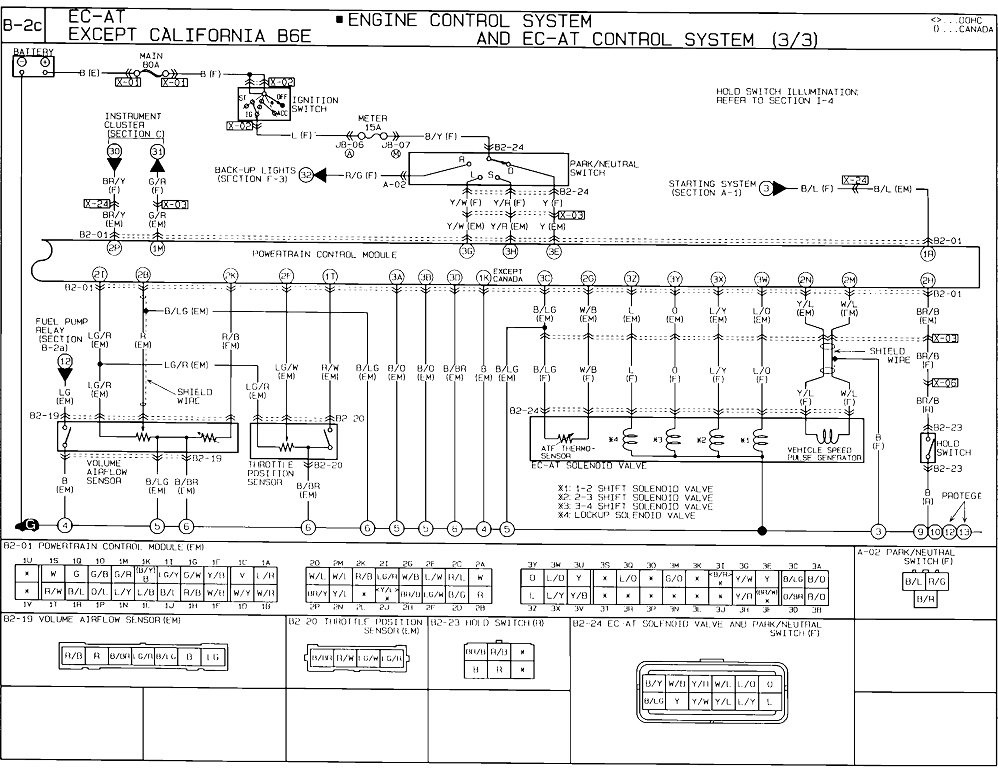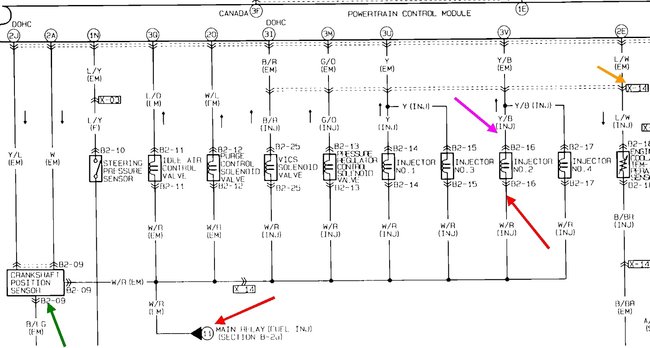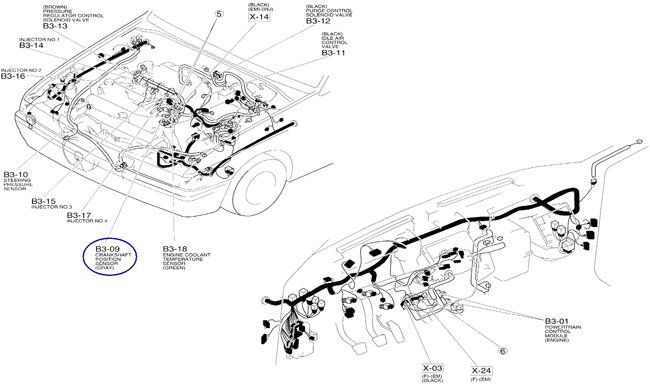The confusion comes from when you expect to see certain voltages. These three diagrams cover the Engine Computer and controls. Unlike most other brands, you will find 12 volts at the injectors with simply turning the ignition switch to "run". The blue arrows show where 12 volts comes from the ignition switch and turns on the main relay. On other brands, that doesn't occur until the engine is rotating, (cranking or running). That's done to insure the injectors are turned off if a fuel line is ruptured in a crash so raw gas doesn't get dumped on the ground.
Once the main relay is turned on, it switches 12 volts onto the circuit with my red arrows, ending at bullet # 11.
Moving to the second diagram, # 11 continues to the red arrows and includes appearing on the wires that are the same color at all the injectors. That appears to be a white / red tracer, (stripe). That's the wire you should see 12 volts on all the time. Where the confusion comes in is the four individual yellow wires. Those are the ground, or in this case, the control wires. They're only using two switching circuits. Each circuit fires two injectors together at the same time. The Engine Computer grounds those wires when it wants to fire those injectors. With 12 volts on the white / red wire, and 0 volts on the yellow wire, the difference is 12 volts and the injector pops open its valve so fuel can spray out. At the precise time, the computer removes the ground on the yellow wire to turn the injectors off. This is when you'll find 12 volts on both wires. It's coming in on the white / red wire, passes through the coil of wire inside the injector, and will be seen on the yellow wire, as long as the connector is plugged in. If you were to unplug the injector, you would no longer see the 12 volts on the yellow wire.
The important point is the difference in voltages on those two wires at each injector. If that were to be 12 volts all the time, like you read online, the injectors would be held open continuously and it would bleed fuel pressure off to 0 psi. That's one way we remove fuel pressure before working in the system. That also leads to a very long crank time to get the engine started next time. That fuel pressure is supposed to hold for days and even weeks without dropping significantly.
This whole story is irrelevant though. The engine runs fine so we know the injectors and its wiring harness are okay. Even if the computer had an intermittent problem related to the injectors, that would only affect the two injectors on that one yellow wire. The symptom would be different. We need to look at what everything has in common when the engine doesn't start. Most notably that's the crankshaft position sensor, (green arrow). I could be wrong, but as I recall, when the crank sensor fails, you won't have injector pulses or spark. There's also a pick-up assembly inside the distributor. On most models from the '90s when they use both sensors, they both have to provide timing signals to get spark and injector pulses. If either sensor fails, both systems are dead. Around the early 2000s we started seeing engines that would still start and run in a back-up mode when one sensor fails. Regardless, the next time the problem occurs, check for spark first before the problem goes away.
For the benefit of others researching this topic, this article might be of help:
https://www.2carpros.com/articles/how-to-test-an-ignition-system
The best clue is in your last paragraph. Crankshaft position sensors and camshaft position sensors, (distributor pick-up assembly), are notorious on all car brands for failing by becoming heat-sensitive, then they work again after they cool down for about an hour. The misery can come from trying to figure out which one is failing. You can start by looking at this page:
https://www.2carpros.com/articles/diagnostic-trouble-codes-for-1995-and-earlier-mazda-cars-obd1
to see if you can read the diagnostic fault codes. If you are lucky, you may find code 02 or 03 to direct you to the failing sensor. If there is no code related to either of them, that is not conclusive. Often on some models, (Chryslers, for example), they need some time to detect the missing signal, as in when a stalled engine is coasting to a stop. Simply cranking the engine is often not long enough for that to get detected. In that case the missing signal is real easy to determine if you have a scanner, but not just by reading fault codes. It's also important to read and record the fault codes before you disconnect the battery or run it dead, otherwise the codes can self-erase, then that valuable information will be lost.
There's two symptom descriptions we see over and over related to crank and cam sensors. One is the engine starts and runs fine for perhaps as much as 15 minutes, then stalls, leaving you sitting on the side of the road. It will restart after about an hour on a cool day. The more common description is the engine runs fine as long as you're driving, due to natural air flow keeping the sensors cool, then, after stopping for a few minutes, such as when getting fuel, the engine won't restart. Engine heat has time to migrate up to the sensors leading to the failure of one of them. Again, the engine will restart after waiting up to an hour.
Let me know if this gets you looking in a different direction, or if I can clarify anything.
SPONSORED LINKS
Sunday, March 27th, 2022 AT 8:08 PM
